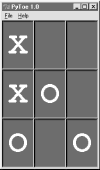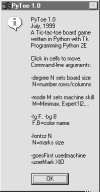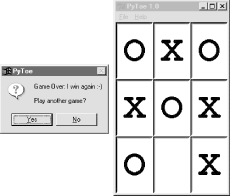PyToe: A Tic-Tac-Toe Game Widget
PyToe A Tic Tac Toe Game Widget
Finally, a bit of fun to close out this chapter. Our last example, PyToe, implements an artificially intelligent tic-tac-toe (sometimes called "naughts and crosses") game-playing program in Python. Most readers are probably familiar with this simple game, so I won't dwell on its details. In short, players take turns marking board positions, in an attempt to occupy an entire row, column, or diagonal. The first player to fill such a pattern wins.
In PyToe, board positions are marked with mouseclicks, and one of the players is a Python program. The gameboard itself is displayed with a simple Tkinter GUI; by default, PyToe builds a 3-by-3 game board (the standard tic-tac-toe setup), but can be configured to build and play an arbitrary N-by-N game.
When it comes time for the computer to select a move, artificial intelligence (AI) algorithms are used to score potential moves and search a tree of candidate moves and countermoves. This is a fairly simple problem as gaming programs go, and the heuristics used to pick moves are not perfect. Still, PyToe is usually smart enough to spot wins a few moves in advance of the user.
9.8.1 Running PyToe
PyToe's GUI is implemented as a frame of packed labels, with mouse-click bindings on the labels to catch user moves. The label's text is configured with the player's mark after each move, computer or user. The GuiMaker class we coded earlier in this chapter is also reused here to add a simple menu bar at the top (but no toolbar is drawn at the button, because PyToe leaves its descriptor empty). By default, the user's mark is "X", and PyToe's is "O". Figure 9-24 shows PyToe on the verge of beating me one of two ways.
Figure 9-24. PyToe thinks its way to a win

Figure 9-25 shows PyToe's help pop-up dialog, which lists its command-line configuration options. You can specify colors and font sizes for board labels, the player who moves first, the mark of the user ("X" or "O"), the board size (to override the 3-by-3 default), and the move selection strategy for the computer (e.g., "Minimax" performs a move tree search to spot wins and losses, and "Expert1" and "Expert2" use static scoring heuristics functions).
Figure 9-25. PyToe help pop-up with options info

The AI gaming techniques used in PyToe are CPU-intensive, and some computer move selection schemes take longer than others, but their speed varies mostly with the speed of your computer. Move selection delays are fractions of a second long on my 650 MHz machine for a 3-by-3 game board, for all "-mode" move-selection strategy options.
Figure 9-26 shows an alternative PyToe configuration just after it beat me. Despite the scenes captured for this book, under some move selection options, I do still win once in awhile. In larger boards and more complex games, PyToe's move selection algorithms become even more useful.
Figure 9-26. an alternative layout

9.8.2 PyToe Source Code (on CD)
PyToe is a big system that assumes some AI background knowledge and doesn't really demonstrate anything new in terms of GUIs. Partly because of that, but mostly because I've already exceeded my page limit for this chapter, I'm going to refer you to the book's CD (view CD-ROM content online at http://examples.oreilly.com/python2) for its source code rather than listing it all here. Please see these two files in the examples distribution for PyToe implementation details:
- PP2EAiTicTacToe ictactoe.py, a top-level wrapper script
- PP2EAiTicTacToe ictactoe_lists.py, the meat of the implementation
If you do look, though, probably the best hint I can give you is that the data structure used to represent board state is the crux of the matter. That is, if you understand the way that boards are modeled, the rest of the code comes naturally.
For instance, the lists-based variant uses a list-of-lists to representation the board's state, along with a simple dictionary of entry widgets for the GUI indexed by board coordinates. Clearing the board after a game is simply a matter of clearing the underlying data structures, as shown in this code excerpt from the examples named above:
def clearBoard(self): for row, col in self.label.keys(): self.board[row][col] = Empty self.label[(row, col)].config(text=' ')
Similarly, picking a move, at least in random mode, is simply a matter of picking a nonempty slot in the board array and storing the machine's mark there and in the GUI (degree is the board's size):
def machineMove(self): row, col = self.pickMove() self.board[row][col] = self.machineMark self.label[(row, col)].config(text=self.machineMark) def pickMove(self): empties = [] for row in self.degree: for col in self.degree: if self.board[row][col] == Empty: empties.append((row, col)) return random.choice(empties)
Finally, checking for an end-of-game state boils down to inspecting rows, columns, and diagonals in the two-dimensional list-of-lists board in this scheme:
def checkDraw(self, board=None): board = board or self.board for row in board: if Empty in row: return 0 return 1 # none empty: draw or win def checkWin(self, mark, board=None): board = board or self.board for row in board: if row.count(mark) == self.degree: # check across return 1 for col in range(self.degree): for row in board: # check down if row[col] != mark: break else: return 1 for row in range(self.degree): # check diag1 col = row # row == col if board[row][col] != mark: break else: return 1 for row in range(self.degree): # check diag2 col = (self.degree-1) - row # row+col = degree-1 if board[row][col] != mark: break else: return 1 def checkFinish(self): if self.checkWin(self.userMark): outcome = "You've won!" elif self.checkWin(self.machineMark): outcome = 'I win again :-)' elif self.checkDraw(): outcome = 'Looks like a draw'
Other move-selection code mostly just performs other kinds of analysis on the board data structure or generates new board states to search a tree of moves and countermoves.
You'll also find relatives of these files in the same directory that implement alternative search and move-scoring schemes, different board representations, and so on. For additional background on game scoring and searches in general, consult an AI text. It's fun stuff, but too advanced to cover well in this book.
Introducing Python
- And Now for Something Completely Different
- The Life of Python
- The Compulsory Features List
- Whats Python Good For?
- Whats Python Not Good For?
Part I: System Interfaces
System Tools
- The os.path to Knowledge
- Why Python Here?
- System Scripting Overview
- The sys Module
- The os Module
- Script Execution Context
- Current Working Directory
- Command-Line Arguments
- Shell Environment Variables
- Standard Streams
- File Tools
- Directory Tools
Parallel System Tools
- Telling the Monkeys What to Do
- Forking Processes
- Threads
- Program Exits
- Interprocess Communication
- Pipes
- Signals
- Launching Programs on Windows
- Other System Tools
Larger System Examples I
- Splits and Joins and Alien Invasions
- Splitting and Joining Files
- Generating Forward-Link Web Pages
- A Regression Test Script
- Packing and Unpacking Files
- User-Friendly Program Launchers
Larger System Examples II
- The Greps of Wrath
- Fixing DOS Line Ends
- Fixing DOS Filenames
- Searching Directory Trees
- Visitor: Walking Trees Generically
- Copying Directory Trees
- Deleting Directory Trees
- Comparing Directory Trees
Part II: GUI Programming
Graphical User Interfaces
- Heres Looking at You, Kid
- Python GUI Development Options
- Tkinter Overview
- Climbing the GUI Learning Curve
- The End of the Tutorial
- Python/Tkinter for Tcl/Tk Converts
A Tkinter Tour, Part 1
- Widgets and Gadgets and GUIs, Oh My!
- Configuring Widget Appearance
- Toplevel Windows
- Dialogs
- Binding Events
- Message and Entry
- Checkbutton, Radiobutton, and Scale
- Running GUI Code Three Ways
- Images
A Tkinter Tour, Part 2
- On Todays Menu: Spam, Spam, and Spam
- Menus
- Listboxes and Scrollbars
- Text
- Canvas
- Grids
- Time Tools, Threads, and Animation
- The End of the Tour
- The PyDemos and PyGadgets Launchers
Larger GUI Examples
- Building a Better Mouse Trap
- Advanced GUI Coding Techniques
- Complete Program Examples
- PyEdit: A Text Editor Program/Object
- PyView: An Image and Notes Slideshow
- PyDraw: Painting and Moving Graphics
- PyClock: An Analog/Digital Clock Widget
- PyToe: A Tic-Tac-Toe Game Widget
- Where to Go from Here
Part III: Internet Scripting
Network Scripting
- Tune in, Log on, and Drop out
- Plumbing the Internet
- Socket Programming
- Handling Multiple Clients
- A Simple Python File Server
Client-Side Scripting
- Socket to Me!
- Transferring Files over the Net
- Processing Internet Email
- The PyMailGui Email Client
- Other Client-Side Tools
Server-Side Scripting
- Oh What a Tangled Web We Weave
- Whats a Server-Side CGI Script?
- Climbing the CGI Learning Curve
- The Hello World Selector
- Coding for Maintainability
- More on HTML and URL Escapes
- Sending Files to Clients and Servers
Larger Web Site Examples I
- Things to Do When Visiting Chicago
- The PyMailCgi Web Site
- The Root Page
- Sending Mail by SMTP
- Reading POP Email
- Utility Modules
- CGI Script Trade-offs
Larger Web Site Examples II
- Typos Happen
- The PyErrata Web Site
- The Root Page
- Browsing PyErrata Reports
- Submitting PyErrata Reports
- PyErrata Database Interfaces
- Administrative Tools
- Designing for Reuse and Growth
Advanced Internet Topics
- Surfing on the Shoulders of Giants
- Zope: A Web Publishing Framework
- HTMLgen: Web Pages from Objects
- JPython ( Jython): Python for Java
- Grail: A Python-Based Web Browser
- Python Restricted Execution Mode
- XML Processing Tools
- Windows Web Scripting Extensions
- Python Server Pages
- Rolling Your Own Servers in Python
Part IV: Assorted Topics
Databases and Persistence
- Give Me an Order of Persistence, but Hold the Pickles
- Persistence Options in Python
- DBM Files
- Pickled Objects
- Shelve Files
- SQL Database Interfaces
- PyForm: A Persistent Object Viewer
Data Structures
- Roses Are Red, Violets Are Blue; Lists Are Mutable, and So Is Class Foo
- Implementing Stacks
- Implementing Sets
- Binary Search Trees
- Graph Searching
- Reversing Sequences
- Permuting Sequences
- Sorting Sequences
- Data Structures Versus Python Built-ins
- PyTree: A Generic Tree Object Viewer
Text and Language
- See Jack Hack. Hack, Jack, Hack
- Strategies for Parsing Text in Python
- String Module Utilities
- Regular Expression Matching
- Parser Generators
- Hand-Coded Parsers
- PyCalc: A Calculator Program/Object
Part V: Integration
Extending Python
- Extending Python
- I Am Lost at C
- C Extensions Overview
- A Simple C Extension Module
- The SWIG Integration Code Generator
- Wrapping C Environment Calls
- A C Extension Module String Stack
- A C Extension Type String Stack
- Wrapping C++ Classes with SWIG
Embedding Python
- Embedding Python
- Add Python. Mix Well. Repeat.
- C Embedding API Overview
- Basic Embedding Techniques
- Registering Callback Handler Objects
- Using Python Classes in C
- ppembed: A High-Level Embedding API
- Other Integration Topics
VI: The End
Conclusion Python and the Development Cycle
- Conclusion Python and the Development Cycle
- That s the End of the Book, Now Here s the Meaning of Life
- Something s Wrong with the Way We Program Computers
- The Gilligan Factor
- Doing the Right Thing
- Enter Python
- But What About That Bottleneck?
- On Sinking the Titanic
- So What s Python The Sequel
- In the Final Analysis
- Postscript to the Second Edition
- Appendix A Recent Python Changes
- Section A.1. Major Changes in 2.0
- Section A.2. Major Changes in 1.6
- Section A.3. Major Changes Between 1.3 and 1.5.2
- Appendix B Pragmatics
- Section B.1. Installing Python
- Section B.2. Book Examples Distribution
- Section B.3. Environment Configuration
- Section B.4. Running Python Programs
- Section B.5. Python Internet Resources
- Appendix C. Python Versus C++
EAN: 2147483647
Pages: 245
- The Four Keys to Lean Six Sigma
- Key #1: Delight Your Customers with Speed and Quality
- Beyond the Basics: The Five Laws of Lean Six Sigma
- Making Improvements That Last: An Illustrated Guide to DMAIC and the Lean Six Sigma Toolkit
- The Experience of Making Improvements: What Its Like to Work on Lean Six Sigma Projects
